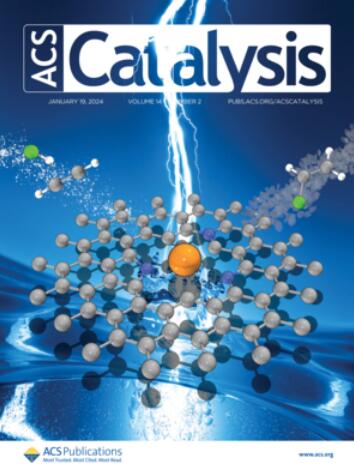Zinc Doping Boosts the Reactivity and Anti-Coking Ability of Cobalt-Based Catalysts for Propane Dehydrogenation
IF 13.1
1区 化学
Q1 CHEMISTRY, PHYSICAL
引用次数: 0
Abstract
The development of environmentally friendly non-noble-metal catalysts for propane dehydrogenation (PDH) has attracted significant attention. CoOx and ZnOx catalysts, known for their relatively high C–H bond activation ability, show great potential. Bimetallic oxide catalysts with dual active sites are particularly promising because of their unique intrinsic properties for PDH. In this study, we synthesized high-performance ZnCoOx oxides supported on Silicalite-1 (S-1) zeolite via a complexation-impregnation method with citric acid. The optimized ZnCoOx/S-1 catalyst demonstrated a propylene formation rate approximately twice as high as that of monometallic CoOx/S-1 or ZnOx/S-1 catalysts. The kinetic analysis and in situ spectroscopy confirmed that bimetallic ZnCoOx species exhibited superior selective activation ability for propane C–H bonds compared to those of monometallic CoOx and ZnOx catalysts. Furthermore, these results demonstrated the dominant role of metallic Co0 sites as the primary active centers for PDH. These features contributed to minimal coke deposition, further improving the catalytic performance. Additionally, reversible transformation between metallic Co0 and the ZnCoOx spinel phase under redox conditions accounts for the good regeneration stability of this catalytic system.

锌掺杂提高了丙烷脱氢钴基催化剂的反应活性和抗结焦能力
开发环保型非贵金属丙烷脱氢催化剂已引起人们的广泛关注。CoOx和ZnOx催化剂以其较高的C-H键活化能力而闻名,表现出很大的潜力。具有双活性位点的双金属氧化物催化剂因其独特的内在性质而具有广阔的应用前景。在本研究中,我们采用柠檬酸络合-浸渍法制备了负载在硅石-1 (S-1)分子筛上的高性能氧化锌。优化后的ZnCoOx/S-1催化剂的丙烯生成速率约为单金属CoOx/S-1或ZnOx/S-1催化剂的两倍。动力学分析和原位光谱分析证实,与单金属CoOx和ZnOx催化剂相比,双金属ZnCoOx对丙烷C-H键具有更强的选择性活化能力。此外,这些结果表明金属Co0位点作为PDH的主要活性中心起主导作用。这些特点有助于减少焦炭沉积,进一步提高催化性能。此外,金属Co0与ZnCoOx尖晶石相在氧化还原条件下发生可逆转变,使得该催化体系具有良好的再生稳定性。
本文章由计算机程序翻译,如有差异,请以英文原文为准。
求助全文
约1分钟内获得全文
求助全文
来源期刊

ACS Catalysis
CHEMISTRY, PHYSICAL-
CiteScore
20.80
自引率
6.20%
发文量
1253
审稿时长
1.5 months
期刊介绍:
ACS Catalysis is an esteemed journal that publishes original research in the fields of heterogeneous catalysis, molecular catalysis, and biocatalysis. It offers broad coverage across diverse areas such as life sciences, organometallics and synthesis, photochemistry and electrochemistry, drug discovery and synthesis, materials science, environmental protection, polymer discovery and synthesis, and energy and fuels.
The scope of the journal is to showcase innovative work in various aspects of catalysis. This includes new reactions and novel synthetic approaches utilizing known catalysts, the discovery or modification of new catalysts, elucidation of catalytic mechanisms through cutting-edge investigations, practical enhancements of existing processes, as well as conceptual advances in the field. Contributions to ACS Catalysis can encompass both experimental and theoretical research focused on catalytic molecules, macromolecules, and materials that exhibit catalytic turnover.
 求助内容:
求助内容: 应助结果提醒方式:
应助结果提醒方式:


